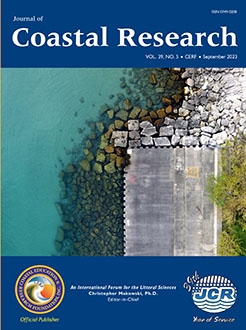Zulaikah, S.; Bijaksana, S.; Azzahro, R.; Daryanti, N.Y.; Wahyuni, L.T.; Sari, M.; Hafiz, A., and Yunginger, R., 2023. Frequency-dependent magnetic susceptibility and chemical composition of estuary mangrove sediment as environmental indicator of ecosystem degradation. Journal of Coastal Research, 39(5), 862–868. Charlotte (North Carolina), ISSN 0749-0208.
In this study, frequency-dependent magnetic susceptibility (χfd%) was combined with the chemical content of sediments for an assessment of mangrove ecosystem degradation. Sediments from three mangrove forest sites were characterized in this study with different environmental backgrounds, i.e. Wonorejo mangroves in Surabaya (WN), Clungup mangroves in Malang (CP), and Cengkrong mangroves in Trenggalek (CG), all of which are in East Java, Indonesia. The χfd% values, which indicate the distribution of magnetic minerals in the samples, were 1.94%, 2.52%, and 0.57%, respectively. Meanwhile, the low-frequency magnetic susceptibility (χlf) was in the range of 44–1405 × 10–8 m3 kg–1 with an average of 391 × 10–8 m3 kg–1 for WN, 3–1400 × 10–8 m3 kg–1 with an average of 313 × 10–8 m3 kg–1 for CP, and 213–1261 × 10–8 m3 kg–1 with an average of 761 × 10–8 m3 kg–1 for CG. It was determined that mangrove sediment with an industrial or urban background, such as in WN and CP, had χfd% in the range of 2% or greater, with an average χlf of around 300 × 10–8 m3 kg–1. On the contrary, mangrove sediment with an unspoiled environmental background such as CG showed low χfd% values of less than 2% and an average χlf of around 700 × 10–8 m3 kg–1. Ni, Cu, and Zn were distinguishing chemical elements in the three mangrove sites. For WN and CP, the average of these elements was higher than that at CG. WN was also marked by an abundance of V, Cr, Mn, and Fe. The magnetic minerals, based on scanning electron microscope analysis, showed some spherule shapes, especially for WN, and an abundance of crystalline shapes, especially for CG.





